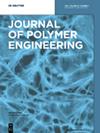The consequences of removing fluorinated compounds from rigid contact lenses
IF 1.7
4区 工程技术
Q4 POLYMER SCIENCE
引用次数: 0
Abstract
Abstract Fluorine free analogues of three commercially available rigid contact lens materials were prepared by replacing the fluorinated component, hexafluoroisopropyl methacrylate (HFPM), with the widely used, non-fluorinated monomers methyl methacrylate (MMA) and 3-methacryloxypropyltris-(trimethylsiloxy)silane (TRIS). The properties of the commercial materials and analogues were measured and compared. The oxygen permeabilities of the MMA analogues were found to be significantly lower than those of the commercial materials, decreasing by 87 % on average, while the TRIS analogues lacked sufficient hardness, dimensional stability and lipid deposit resistance to be viable for use in rigid contact lenses. Analogues prepared using a 1:1 mixture of MMA and TRIS had the best overall combination of properties, but were still on average 47 % less permeable to oxygen and also significantly less resistant to lipid deposition. The analogues prepared in this study did not adequately replicate the performance of marketed, fluorine containing rigid contact lens materials. These observations give an indication of the challenges that would face contact lens material manufacturers in preparing rigid lens polymers without the use of fluorinated species. A reduction in effectiveness would be almost inevitable, and would be expected to have a negative impact on the safety and eye health of rigid contact lens patients.从硬性隐形眼镜中去除含氟化合物的后果
摘要通过用广泛使用的非氟化单体甲基丙烯酸甲酯(MMA)和3-甲基丙烯酰氧基丙基三-(三甲基甲硅氧基)硅烷(TRIS)代替氟化组分甲基丙烯酸六氟异丙酯(HFPM),制备了三种市售刚性隐形眼镜材料的无氟类似物。对商业材料和类似物的性能进行了测量和比较。MMA类似物的透氧性明显低于商业材料,降低了87 % 平均而言,而TRIS类似物缺乏足够的硬度、尺寸稳定性和抗脂质沉积性,无法在刚性隐形眼镜中使用。使用MMA和TRIS的1:1混合物制备的类似物具有最佳的整体性能组合,但仍平均为47 % 对氧气的渗透性较低,并且对脂质沉积的抵抗力也明显较低。本研究中制备的类似物没有充分复制市场上含氟刚性隐形眼镜材料的性能。这些观察结果表明,隐形眼镜材料制造商在不使用氟化物质的情况下制备刚性镜片聚合物时将面临挑战。有效性的降低几乎是不可避免的,预计会对刚性隐形眼镜患者的安全和眼睛健康产生负面影响。
本文章由计算机程序翻译,如有差异,请以英文原文为准。
求助全文
约1分钟内获得全文
求助全文
来源期刊

Journal of Polymer Engineering
工程技术-高分子科学
CiteScore
3.20
自引率
5.00%
发文量
95
审稿时长
2.5 months
期刊介绍:
Journal of Polymer Engineering publishes reviews, original basic and applied research contributions as well as recent technological developments in polymer engineering. Polymer engineering is a strongly interdisciplinary field and papers published by the journal may span areas such as polymer physics, polymer processing and engineering of polymer-based materials and their applications. The editors and the publisher are committed to high quality standards and rapid handling of the peer review and publication processes.
 求助内容:
求助内容: 应助结果提醒方式:
应助结果提醒方式:


